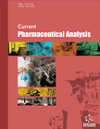- Home
- A-Z Publications
- Current Pharmaceutical Analysis
- Previous Issues
- Volume 18, Issue 7, 2022
Current Pharmaceutical Analysis - Volume 18, Issue 7, 2022
Volume 18, Issue 7, 2022
-
-
Research Progress on Quantification Methods of Drug Concentration of Monoclonal Antibodies
More LessAuthors: Jinlu Zhang, Linlin Hu and Hua ShaoBackground: With the development of monoclonal antibodies (mAbs) from the first generation of mice to the fourth generation of human origin, the efficacy and safety in the treatment of many diseases have been continuously improved. MAbs have been widely used in the treatment of cancer, chronic inflammatory diseases, etc. However, the treatment response of mAbs varies greatly among individuals, and drug expo Read More
-
-
-
Application of Analytical Tools and Techniques for Estimation of a Proton Pump Inhibitor (Esomeprazole Magnesium Trihydrate): A Comprehensive Review
More LessThe application of various sophisticated analytical tools and techniques is essential for estimating an active pharmaceutical ingredient present in either biofluids or pharmaceutical dosage forms. Reporting the multiple analytical methods used to quantify esomeprazole magnesium trihydrate, a proton pump inhibitor, is the ultimate goal of this review article. This article deals with a detailed discussion of different reported analytic Read More
-
-
-
Application of Gas Chromatography for the Analysis of Residual Solvents in Transdermal Drug Delivery Systems (TDS)
More LessAuthors: Diaa Shakleya, Sonal Mazumder, Naresh Pavurala, Sara Mattson and Patrick J. FaustinoBackground: Transdermal drug delivery systems (TDS) are widely used to deliver a number of different drug therapeutics. The design delivery can be impacted by excipients and, more broadly, organic solvents. Organic or residual solvents are routinely monitored due to safety concerns. However, there is little information on the mechanical properties and delivery performance of TDS. Objective: The objective of this study Read More
-
-
-
Analysis of Shenhuang Capsule using HPLC: Method Development, Validation, and Application
More LessAuthors: Yuankai Si, Zhigui Wu, Gu Li, Hua Li, Pei Ge, Huan Liu, Wenqiang Zhang, Yanli Xu, Yuanqiong Huang and Meijuan ChenObjective: Shenhuang (SH) capsule is a traditional Chinese medicine compound preparation containing rhubarb, coptis, scutellaria, salvia and Pueraria, used for diabetic nephropathy studied by our research group in the early stage. This study aims to develop the method of qualitative identification and content determination of the main active ingredients of SH capsules so as to establish the quality standard. Methods: Read More
-
-
-
Isolation and Characterization of An Allergic Dimer Impurity in Cefmenoxime Hydrochloride by NMR and HR-MS Method
More LessAuthors: Jin Li, Shang-Chen Yao, Li-hui Yin, Chang-Qin Hu and Ming-Zhe XuBackground: We systematically characterized an allergic dimer impurity in cefmenoxime hydrochloride raw material by UV, IR, HR-MS, 1D, and 2D NMR for the first time. Methods: The dimer stock solution of cefmenoxime hydrochloride was obtained by the degradation method. The target dimer impurity in the stock solution was separated by preparative RP-HPLC and purified by the freeze-drying method. By comparing the Read More
-
-
-
Characterization of Allergic Polymerized Impurities in Cephalosporins by MALDI-TOF MS/MS Spectrometry
More LessAuthors: Dandan Wang and Jian WangBackground:Characterization of allergic polymerized impurities in cephalosporins is significant to ensure the safety and quality of the products. Objective: The aim of the study was to develop a MALDI-TOF MS/MS method to characterize the structures of polymerized impurities in cefuroxime axetil drug substance and cefetamet pivoxil drug substance. Methods: Calibrant references were TOF mix, including Angiotensin 2, Angi Read More
-
-
-
Volatile Chemical Profile of Ethanol-based Hand Sanitizer Marketed in Brazil by HS-SPME/GC-MS
More LessAims: This study aims to determine the volatile chemical profile of ethanol-based hand sanitizer marketed in Brazil by HS-SPME/GC-MS. Background: Ethanol-based hand sanitizer has been used to protect against coronavirus disease (COVID-19). In general, these formulations are prepared using a carbomer. In 2020 and 2021, the production of hand sanitizer has increased due to the COVID-19 epidemic. Therefore, it is important to Read More
-
Volumes & issues
-
Volume 20 (2024)
-
Volume 19 (2023)
-
Volume 18 (2022)
-
Volume 17 (2021)
-
Volume 16 (2020)
-
Volume 15 (2019)
-
Volume 14 (2018)
-
Volume 13 (2017)
-
Volume 12 (2016)
-
Volume 11 (2015)
-
Volume 10 (2014)
-
Volume 9 (2013)
-
Volume 8 (2012)
-
Volume 7 (2011)
-
Volume 6 (2010)
-
Volume 5 (2009)
-
Volume 4 (2008)
-
Volume 3 (2007)
-
Volume 2 (2006)
-
Volume 1 (2005)
Most Read This Month
Article
content/journals/cpa
Journal
10
5
false
en


